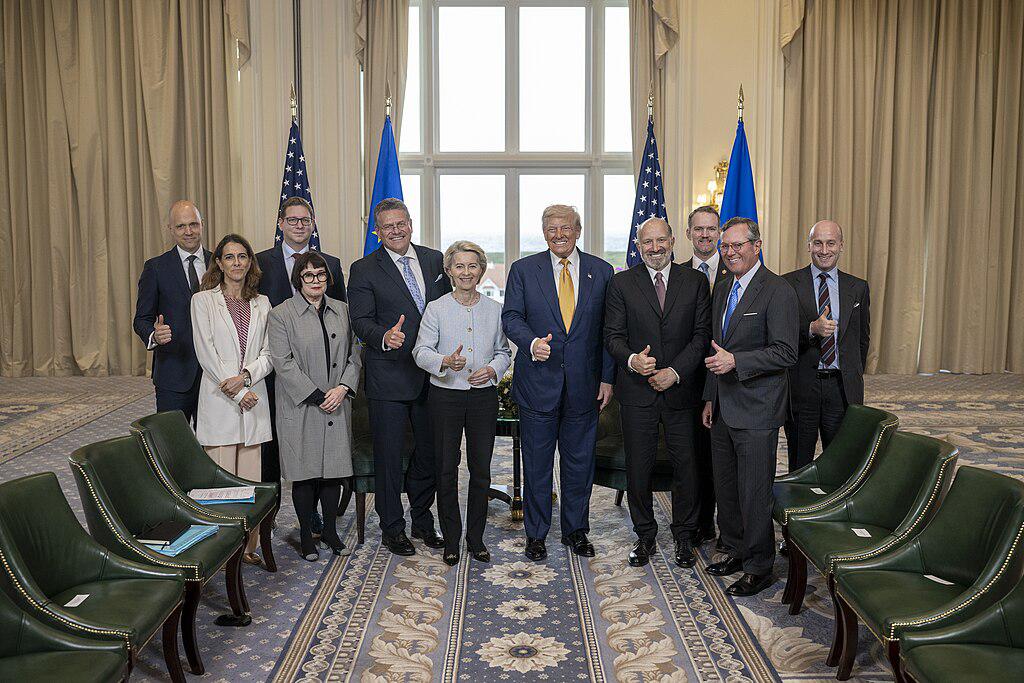By: Rob Roos, Distinguished Fellow
The US-EU trade agreement of July 2025 is not just a recalibration of tariffs and quotas—it’s a bold acknowledgment that advanced economies are prioritizing national resilience over the dogma of unfettered globalism. In a world of weaponized supply chains and geopolitical flux, this deal reflects a pragmatic shift toward sovereignty, but its benefits and costs are unevenly distributed. For the United States, it’s a strategic win; for Europe, it’s a fragile compromise that masks deeper vulnerabilities.
A Triumph for the United States
For the US, the deal is a masterstroke of economic and geopolitical strategy. By securing increased access for energy exports—potentially worth hundreds of billions over the next decade—and attracting European investment in manufacturing and AI, the agreement bolsters key sectors. It’s not just about dollars. It’s about reversing decades of offshoring that hollowed out industrial heartlands. Towns in Ohio and Michigan stand to gain from reshored factories, supported by pro-business policies and cheap domestic energy. The deal also cements US energy dominance, with LNG exports to Europe projected to reach 25% of EU gas supply by 2030, reducing reliance on volatile suppliers.
Critics argue that tariffs risk inflation and higher consumer prices. They’re not wrong—US import prices could rise by 2–3% in the short term. But for many Americans, stable jobs and national security outweigh marginal cost increases. The working class, long sidelined by coastal elites chasing efficiency, finally sees policy aligned with their needs.
Europe’s Precarious Truce
Europe, by contrast, has secured a tactical reprieve rather than a strategic victory. By averting a tariff war, the EU protects its export-driven economies, particularly Germany’s automotive sector (€250 billion in exports annually) and Ireland’s pharmaceuticals. Zero tariffs on semiconductors and aviation preserve high-value industries, while increased US LNG imports support energy diversification, cutting reliance on Russian gas (down to 8% of EU supply in 2024). Yet these gains come at a cost. Europe’s industries face structural pressures: German manufacturers grapple with energy costs 2–3 times higher than in the US, while Central European suppliers risk losing ground to American competitors offering lower costs and subsidies.
Wealthier EU states like Germany and the Netherlands may absorb these shocks, but southern and eastern Europe—already strained by high debt (e.g., Italy’s 140% debt-to-GDP ratio) and lower wages—face growing risks. Rising living costs, with inflation at 2.5% in 2025, hit households hard, particularly in Greece and Romania, where real incomes have stagnated. The deal’s focus on large industries overlooks small and medium enterprises, which employ 60% of EU workers and struggle with trade compliance costs.
Moreover, the agreement deepens Europe’s dependence on US energy, trading one external reliance (Russia) for another. This is not sovereignty restored but deferred. The EU’s push for renewables under the European Green Deal—aiming for 45% renewable energy by 2030—offers a path to self-reliance, but progress is uneven, and the deal does little to accelerate it.
The Bigger Picture: Sovereignty, China, and Society
This deal is not about economic optimality; it’s about geopolitical realism. Tariffs and industrial policies may distort markets, but they build resilience in a world where supply chains are strategic weapons. Both the US and EU are responding to China’s dominance in critical goods like semiconductors and rare earths. A true transatlantic partnership would align on reducing China’s leverage, perhaps through joint investment in chip production or green tech.
The deal also sidesteps digital trade and data privacy, where US-EU tensions (e.g., GDPR vs. US tech giants) remain unresolved. Without progress here, the agreement misses a chance to shape the digital economy. Socially, Europe risks further fragmentation. Economic strain in southern and eastern member states could fuel populist movements, as seen in Italy and Hungary, undermining EU unity.
A Necessary but Incomplete Step
The US-EU trade deal of 2025 marks the end of naive globalism and the return of strategic pragmatism. For the US, it’s a step toward industrial revival and energy dominance. For Europe, it’s a pause that preserves stability but exposes long-term vulnerabilities. To compete, the EU must double down on self-reliance—through affordable energy, diversified supply chains, and support for SMEs—while addressing social discontent to prevent political fracturing.
Economic inefficiencies may arise, but in a world of strategic decoupling, sovereignty is not a luxury—it’s a necessity. The US has seized this moment; Europe must find the courage to do the same, lest it remain a market bloc tethered to external powers. This deal is not the final chapter but a call to action for both sides to redefine prosperity in an age of uncertainty.
Rob Roos is a distinguished fellow at the Gold Institute for International Strategy, a Washington, DC-based think-and-do tank.
